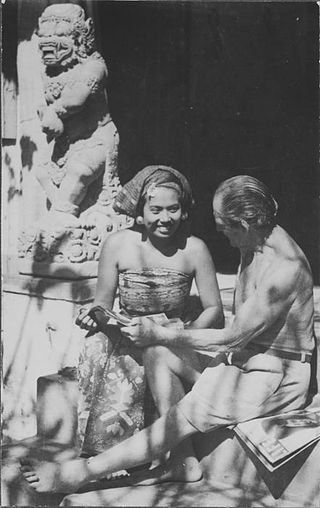
Ubud is a town on the Indonesian island of Bali in Ubud District, located amongst rice paddies and steep ravines in the central foothills of the Gianyar regency. Promoted as an arts and culture centre, it has developed a large tourism industry. It forms a northern part of the Greater Denpasar metropolitan area.

Yuri Gorbachev is a Russian painter and sculptor.
Adrianus Wilhelmus "Arie" Smit was a Dutch-born Indonesian painter who lived on Bali.

Balinese art is art of Hindu-Javanese origin that grew from the work of artisans of the Majapahit Kingdom, with their expansion to Bali in the late 14th century. From the sixteenth until the twentieth centuries, the village of Kamasan, Klungkung, was the centre of classical Balinese art. During the first part of the twentieth century, new varieties of Balinese art developed. Since the late twentieth century, Ubud and its neighboring villages established a reputation as the center of Balinese art.
Nyoman Rudana is a former member of the Regional Representatives Council of Indonesia. He is also the founder and owner of Museum Rudana, Rudana Fine Art Gallery and Genta Fine Art Gallery, and founder of artist support organizations in Ubud, Bali.
Hotel Tjampuhan & Spa, better known as the Tjampuhan Hotel is a historic hotel in Ubud, on the island of Bali, Indonesia. The Tjampuhan is the second-oldest hotel in Bali, trailing only the Natour Bali Hotel that opened in 1927. It is run and owned by the Tjampuhan Group under Tjokorda Oka Artha Ardhana Sukawati and his family.

Johan Rudolf Bonnet was a Dutch artist who lived much of his life in the town of Ubud on Bali, Indonesia. He was born into a Dutch Huguenot-descended family who had been bakers for many generations. He attended the Rijksakademie van Beeldende Kunsten in Amsterdam.
I Nyoman Masriadi is a painter and a leading artist of the post-Suharto era in Indonesia. His works have gained a collectors base which includes prominent collectors in and around the region.

Adrien-Jean Le Mayeur de Merprès was a Belgian painter from Ixelles who lived the last part of his life in Bali.

Ida Bagus Made Poleng (1915–1999) was a traditional Balinese painter. Known also as Ida Bagus Made Poleng or Ida Bagus Made Tebesaya or simply Gus Made.
Anak Agung Gde Sobrat (1912–1992) was a painter in Indonesia.
I Gusti Nyoman Lempad (1862?–1978) was a Balinese stone sculptor, architect and painter who built palaces and temples in Ubud and its neighboring villages. Lempad's exact birth date, as is the case for many Balinese of his time, is unknown. But he was married when Krakatoa erupted in 1883.
Ida Bagus Nyoman Rai (~1915-2000) was a traditional Balinese painter from Sanur, a beach resort near Denpasar, Bali, Indonesia. He was also known as I Bagus Nyoman Rai Tengkeng or Ida Bagus Nyoman Rai Klingking

The Puri Lukisan Ratna Wartha Museum is the oldest art museum in Bali which specialize in modern traditional Balinese paintings and wood carvings. The museum is located in Ubud, Bali, Indonesia. It is home to the finest collection of modern traditional Balinese painting and wood carving on the island, spanning from the pre-Independence war (1930–1945) to the post-Independence war era. The collection includes important examples of all of the artistic styles in Bali including the Sanur, Batuan, Ubud, Young Artist and Keliki schools.

The Neka Art Museum is a museum located in Ubud on Bali, Indonesia, It was established in 1982 by Pande Wayan Suteja Neka, better known as Suteja Neka, a Balinese art dealer who had begun collecting Balinese art with the advice and help of painters Rudolf Bonnet and Arie Smit among others.

Semarapura is a town which serves as the administrative capital of the Klungkung Regency in Bali, Indonesia.
Gajah Gallery is an art gallery in Singapore that hosts artwork related to the socio-cultural interests of Asia. It was established in 1995 by Jasdeep Sandhu and promotes Southeast Asian Contemporary Art with an emphasis on Indonesian Contemporary. The gallery holds exhibitions, some of which have been collaborations with the Singapore Art Museum (SAM) and the National University of Singapore Museum (NUS). Gajah Gallery is also a member of Art Galleries Association in Singapore.
Balinese literature refers to the oral and written Balinese language literature of the people of Bali, an island in Indonesia. It is generally divided into two periods: purwa, or traditional; and anyar, or modern.

Bentara Budaya Jakarta is a cultural center located on Jalan Palmerah Selatan 17, Central Jakarta, Indonesia. The institution consists of a museum and an art gallery. Open from Monday to Friday at 8 AM to 5 PM, the gallery is closed on weekends and holidays, with an exception being made when special exhibitions are present. Entry to the gallery is free of charge and open to visitors.

Pura Taman Saraswati, officially Pura Taman Kemuda Saraswati, also known as the Ubud Water Palace, is a Balinese Hindu temple in Ubud, Bali, Indonesia. The pura is dedicated to the goddess Sarasvati. Pura Taman Saraswati is notable for its lotus pond.
















